Hydrangea large-leaved Peppermint - a detailed description of the variety
The hydrangea variety Peppermint, or Peppermint, belongs to the popular Forever & Ever series, which Dutch breeders have been working on since 2005 under the leadership of Ard van Claweren. Peppermint was patented in 2008. Arose as a result of controlled crossing between the large-leaved subspecies Sabrina and Slava.
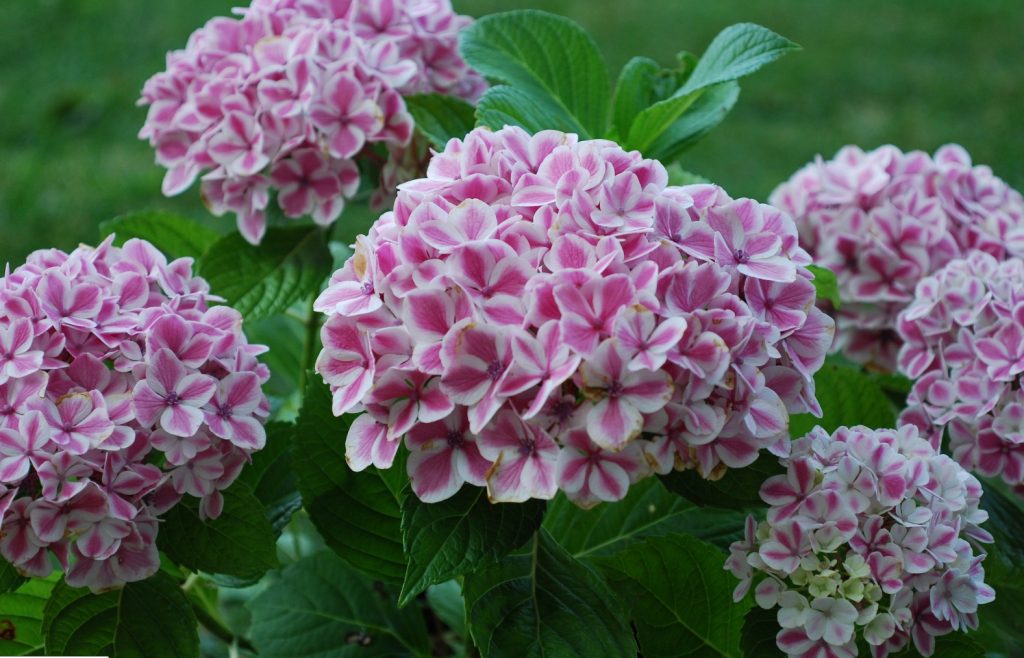
Hydrangea peppermint
Description of the variety
The botanical name of the plant is Hydrangea macrophylla (Thunb.) Peppermint. The variety translates as "Peppermint".
To create it, scientists from Amsterdam pollinated the parent flowers of the generic Sabrina with pollen from the proprietary Glory.
Hydrangea has large attractive inflorescences, distinct sepals pigmentation with a characteristic striped pattern and good consumer characteristics. Excellent transport tolerance.
The shape of the bush is compact, vertical, with a rounded dense crown. In the open field it reaches 90 × 90 cm, in flower pots - 60 × 50 cm. The plant has 7 stems with one large inflorescence on each. The bush branches easily with the formation of shoots at its base.
The lateral branches are similar in shape to the main stems. Green colour. They grow stiff with age. Older parts have a gray-brown tint.
The foliage is abundant, growing in pairs. Length - 16 cm, width - 11 cm. Petioles are 4-5 cm long and 4 mm wide. The shape is elliptical with a sharp base and apex, the edges are serrated. The surface is smooth, with veins visible in the lower part. Above, the color of adult leaves is yellow-green, below it is green.
Flower buds are spherical, 3 mm in diameter, with 4-5 rounded, elliptical, smooth petals. About 100 or more flowers with a diameter of 2-3 cm are grouped in a rounded corymbose or paniculate inflorescence, reaching an average of 13 cm in height and 23 cm in width. Moreover, both sterile (closer to the edge) and small fertile flowers (in the middle) grow on one panicle. Pedicel is strong, erect, 30-40 mm long.
The first to bloom are fertile flowers in the center of the inflorescence. Each of them has 4 petals, which fall off as the fruit ripens. The flowers themselves are white, but the core has distinct stripes or blurry strokes. The color depends on the acidity of the soil and the flowering time. It can be pink, purple, red, crimson, purple, lilac, blue, pale blue - two bushes growing side by side often have different shades.
A feature of the Peppermint variety (as well as the entire Forever & Ever series) is its long flowering from July to October frosts. This is due to the ability of peduncles to form on both young and last year's shoots. Even if old stems are damaged in winter, hydrangea will still bloom on new shoots in summer - a wonderful quality for the climate of the middle zone.
The phenotype can vary significantly depending on environmental conditions, soil acidity, temperature, sunlight intensity and daylight hours.The Peppermint Twist shape has predominantly white sepals with a reddish-purple border.
Landing features
Hydrangea large-leaved Peppermint is passionate about water. But this does not mean that it should be planted in a puddle, or a swamp. From excess moisture, the roots will probably rot, and the leaves and stems are occupied by powdery mildew or other fungus. To do this, drainage is made in the planting pit from expanded clay, broken red brick or crushed stone 10-15 cm thick. That is, it is necessary to ensure that the soil is slightly moist, but the excess water goes into the ground.
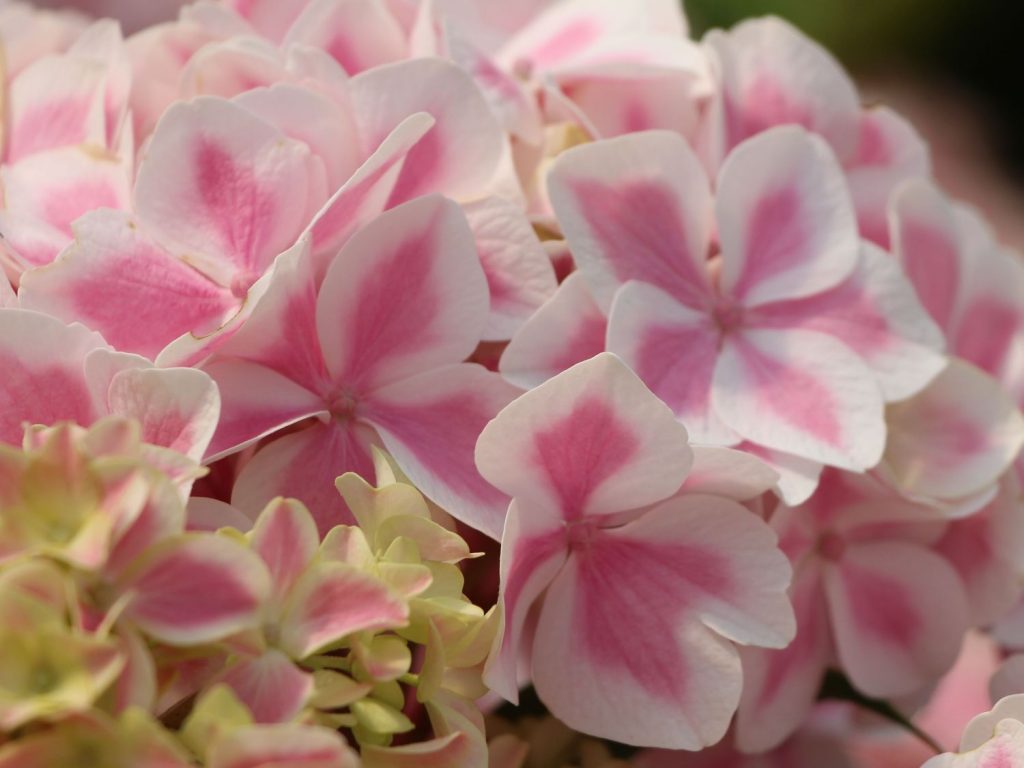
Hydrangea large-leaved peppermint
Clay is ideal for retaining moisture. But this type of soil is too heavy - the roots need air. It is preferable to plant the plant on loams, which have an upper loose fertile layer and dense soils below, holding water a little deeper than the horse system.
In many ways, the decorative appearance and color of flowers depend on the composition of the soil:
- pH 5.0-5.5 - blue;
- pH 5.8-6.2 - pink;
- pH 6.3-6.5 - crimson red;
- pH over 6.5 - violet.
Gardeners have the opportunity to change the color at will, changing the acidity of the soil by adding chalk or preparations containing aluminum.
The planting process is as follows:
- Dig a hole in proportion to the seedling. For an adult bush, it can reach 50x50x50 cm. If drainage is required, the depth is increased by 10-15 cm. In general, the width of the hole should be twice the width of the root ball. Even when planting a cutting, it is wise to dig a full-fledged hole to lay drainage - a bush can grow in this place for decades.
- The pit is sprinkled with earth to the level of the roots, compost can be poured over the drainage or a little complex fertilizer can be added according to the instructions.
- They put a seedling and add half of it.
- The hole is spilled with water to fill the voids.
- Finally, they cover it with earth up to the horse's neck and water it again.
- If cuttings are used, they are protected from the direct scorching sun.
Care
Pruning
An important condition for the life of the large-leaved hydrangea. Dead shoots are removed in March / April before sap flow. Every 5 years in early spring, one third of the old shrub is cut down to rejuvenate the plant.
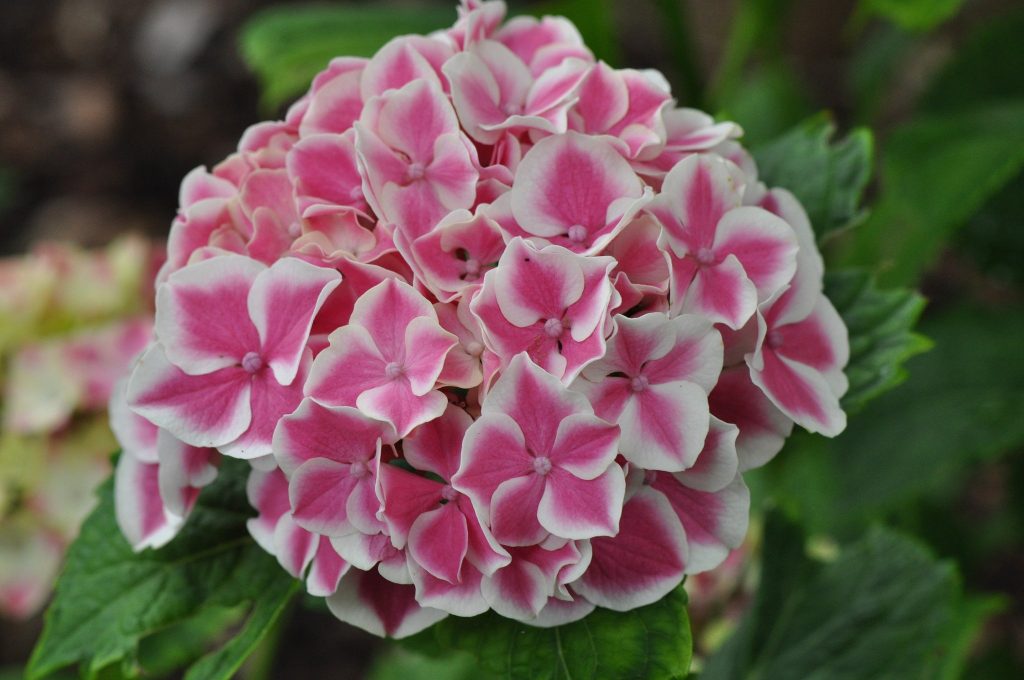
Hydrangea large leaf peppermint
In autumn, dried panicles of inflorescences can not be removed - they will help to additionally insulate the stems from above, weakening the force of the frosty wind and trapping snow. But it is recommended to cut them in the spring to make room for the next generation of flowers.
Watering
Having enough moisture is important for the plant.
- With regular precipitation, the procedure is not carried out.
- In the dry season, water at least once every 2 weeks.
Norm: 15-20 liters for an adult bush, 8-12 liters for a young plant. The water should be separated from chlorine (so that chlorosis of the leaves does not develop), and not hard (so that the acidity of the soil does not decrease). The variety is distinguished by its endurance: with insufficient irrigation, it withers, but quickly recovers after receiving water.
Top dressing
If the soil is poor, 1-2 dressings are carried out in the spring during the season.
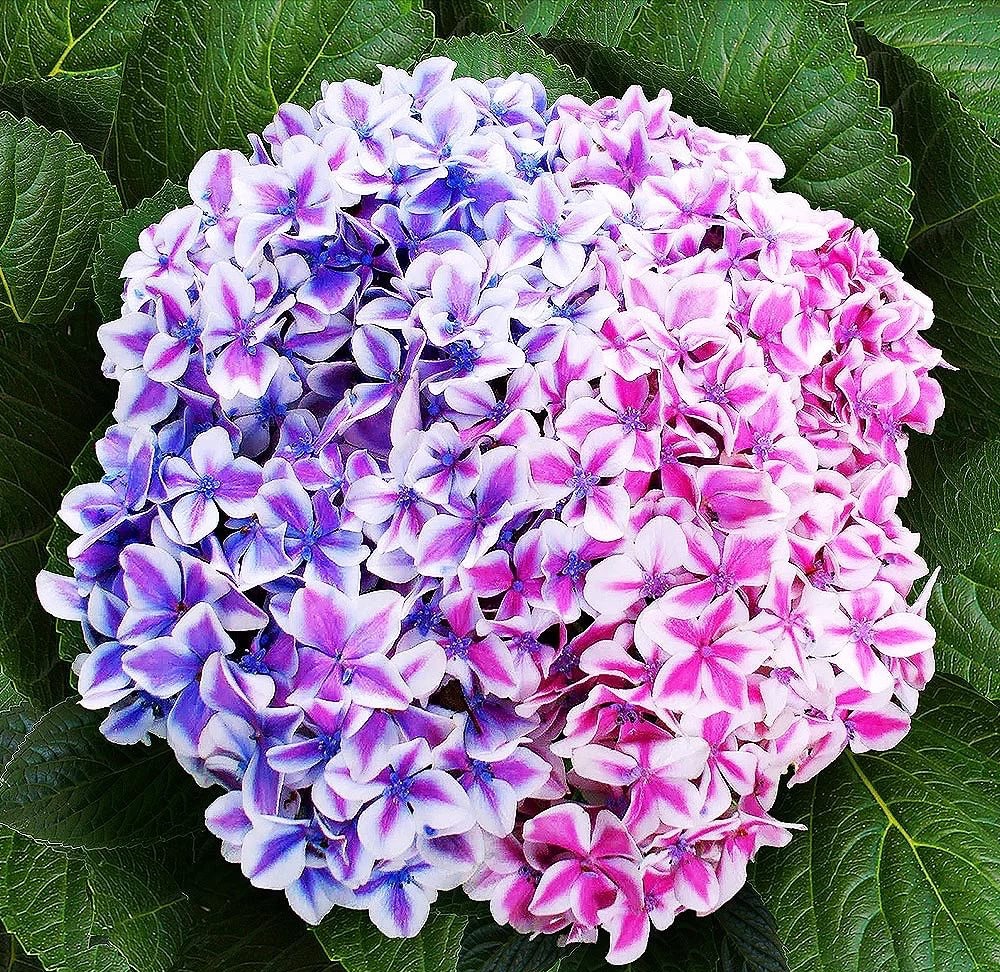
Peppermint hydrangea reviews
The first and obligatory one is at the beginning of the growing season, when the plant is growing. It is advisable to use a complex fertilizer rich in microelements. Immunostimulants will not harm either.
After that, the hole can be mulched with hay, straw, peat, sawdust - so that it will prevent the evaporation of moisture from the root system.
The second dressing is usually done when the buds are tied (June). A mixture of 40 g of potassium sulfate and 60 g of superphosphates has shown itself well. Subsequently, monthly infusion of mullein is fed (1:12).
To prepare for winter - in early September or late August - the hole is filled with rotted manure or compost (1-2 buckets). Before snow falls, re-mulching is carried out in order to retain the moisture of the snow that melts in spring.
Attention! Ash cannot be used to feed large-leaved hydrangea.It helps to reduce the acidity of the soil, and this has a bad effect on the overall development of the plant, its appearance and the intensity of the color spectrum.
Reproduction
To preserve varietal qualities, hydrangea large-leaved Peppermint is propagated asexually. The simplest and most effective method is grafting.
Research shows that varietal characteristics persist for three generations.
Breeding stages:
- A young but well-formed stem is chosen for grafting. Desirable lateral, so as not to disturb the shape of the bush. There are many of them after pruning. Cut it off at a distance of 15-20 cm from the top.
- 1-2 pairs of lower leaves are cut off - roots will appear from their axils. In this case, at least 2 pairs of leaves should remain in the upper part for photosynthesis.
- The lower part of the cutting is placed in a solution of "Kornevin" or its analog for a couple of hours.
- Before planting, disinfect with a fungicide, a weak solution of potassium permanganate or in another way.
- They are planted in the ground or placed in water until the roots appear.
Rooting takes 2-3 weeks in the ground. To speed up the process, you can build a mini greenhouse. It must be ventilated regularly.
Diseases and pests
| Problem | Decision | Prophylaxis |
| Powdery mildew | Remove affected leaves and stems. Treat with lime, preparations based on sulfur or potassium bicarbonate. | Avoid over-watering, weeding, and removing debris and grass from the site. |
| Chlorosis | Clarification of foliage, provoked by an excess of organic matter or lime in the soil, using unsettled tap water for irrigation. First, spray with a solution of potassium nitrate (40 g of substance per 10 liters of water), after a few days - with a solution of ferrous sulfate in similar proportions. | Do not use tap water. Monitor the composition of the soil. |
| Gray rot | Destroy infected parts. Spray with "Topsin", "Fundazol" or copper sulfate. | Avoid waterlogging. Plant in a bright, ventilated place. |
| Slugs, snails | Fish with beer traps. Sprinkle chipped shells, lime, or ash around the base. | Do not litter the site. |
Landscape use
Hydrangea Pepermint belongs to new spectacular varieties, distinguished by large inflorescences, dense juicy green foliage, abundant and long flowering, the ability to change the color of the core of the petals, depending on the composition of the soil.
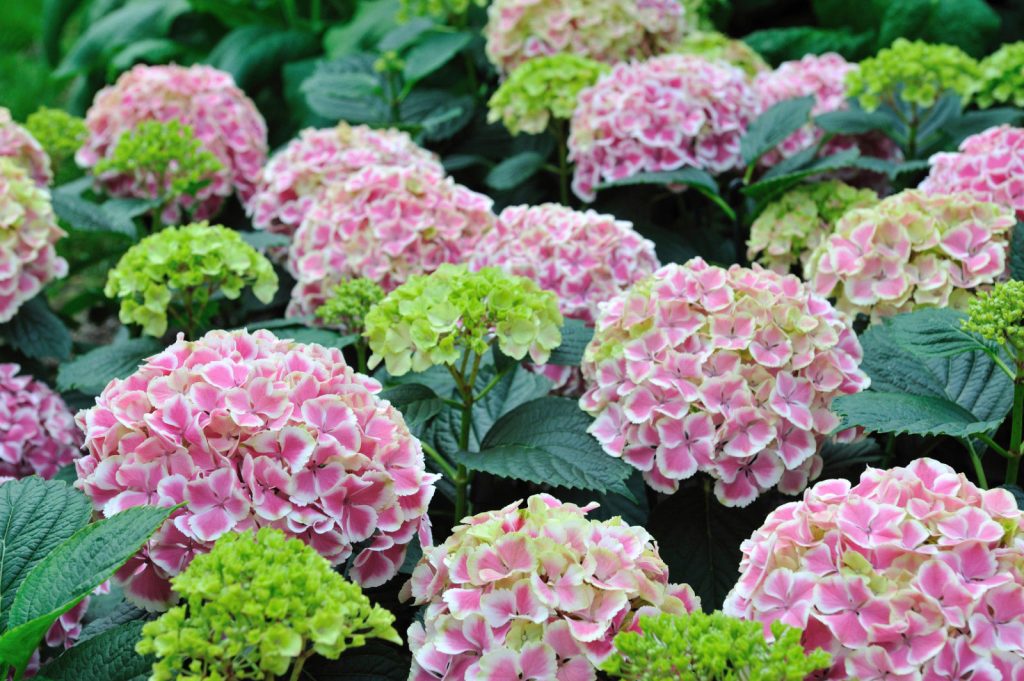
Hydrangea pepermint
It is reasonable to plant them in plain sight, on the first or second line of a flower garden, in border plantings, as well as in tubs.
The best place is an area that is generously illuminated by the sun in the morning hours, and with light partial shade at the peak of the heat.
Testimonials
Hydrangea Peppermint is a relatively new variety and is not so widespread in Russia. But flower growers who had the pleasure of growing it note high decorative qualities. Despite the severity of large inflorescences, the stems do not droop, they stand exactly even after rain.
The plant is hardy and more winter hardy than most of the older varieties of hydrangeas. Judging by the description, it is able to withstand 25-27-degree frosts (winter hardiness zone 5a). But additional cover will not be superfluous.

